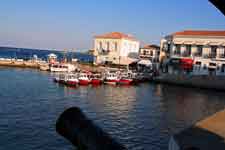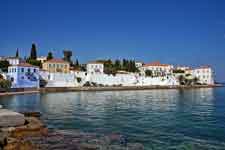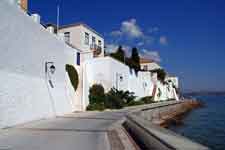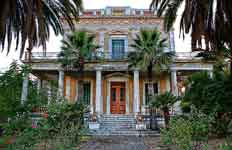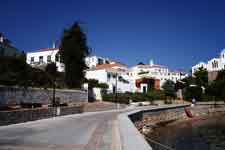.


Administrative Region : Attica
Regional unit : Islands
Spetses (Modern Greek: Σπέτσες, Katharevousa: Σπέτσαι, Spetsai, Ancient: Πιτυούσσα, "Pityoussa") is an island and a municipality in the Islands peripheral unit, Attica, Greece.[1] It is sometimes included as one of the Saronic Islands. Until 1948, it was part of the old prefecture of Argolidocorinthia, which is now split into Argolis and Corinthia. In ancient times, it was known as Pityoussa, and later as Petses. The town of Spetses (pop. 3,846 in 2001) is the only large settlement on the island. The island is presently an independent municipality (pop. 3,916), with no internal boundaries within the municipality. The other settlements on the island are Moní Agíon Pánton (pop. 32), Ligonéri (16), Ágioi Anárgyroi (11), Kouzoúnos (3). Also part of the Municipality of Spetses are the islands of Spetsopoula (pop. 11) and Velopoula (uninhabited).
Ferries and high-speed hydrofoils arrive regularly from Piraeus. The new port is known as Dapia and the old port as [{Baltizar]]. Trails encircle the island and total about 25 to 30 km; beaches include Agios Mamas, in the center of town, Agioi Anargiroi and Agia Paraskevi at the back of the island, Zogeria, and two beaches close to the town, College beach and Agia Marina, both of which offer watersports.
|
|
|
|
|
|
|
|
History
The island of Spetses, located in the Mediterranean Sea, was first occupied during the Mesolithic Age, about in 8000 BC. During that period the island was connected to through an isthmus to the island of Argolida , currently named Costa. Pieces of flint from that time were found near the part of the island called Zogeria that contained a water source probably available since those times. Other archaeological finds were located in the area of Saint Marina, which contained the first Hellenistic settlement to be found on the island and dates to the 3rd millennium BC. At least three natural harbors of Spetses (Saint Marina, Saint Paraskevi and Zogeria) served as a refuge for ships carrying goods to and from the Argolis Gulf during the peak of the State of Lerna (about 2300 BC).
After the collapse of the State of Lerna, Spetses experienced a period of decline. Findings in the areas of Saint Marina and Saint Anargyroi show the existing settlements belonging the late Mycenaean period (12th to 13th century BC). At the time of the Peloponnesian War stone observatories were built at the sites of Prophet Elias and Zogeria.
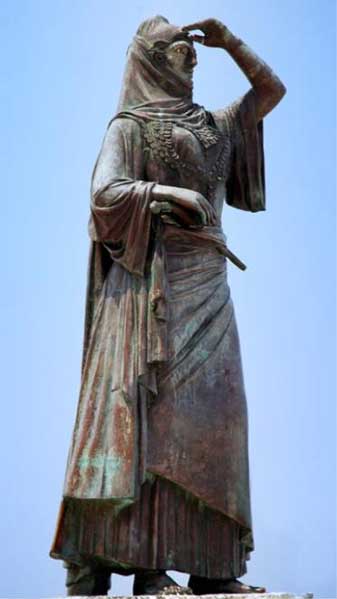
|

Laskarina Bouboulina Museum |
Flag of Spetses during the Greek War of Independence.
Mentions of the island of Spetses were made by both Strabo in the 1st century BC and by Pausanias in the 2nd century AD referring to the island as Pitiousa. The raid by the Goths in the Eastern Roman empire caused a wave of refugees to flee to Spetses, resulting in the re-settlement of the island, focusing on the Old Port, making it one of the three largest cities of Argolis (including Argos and Hermione).
In the 15th Century, the Venetians named the island Spezia ("Spice") for its position on a major traderoute; over time the name was Hellenised to "Spetsai".
During the 18th century, during the conquest of the Peloponnese from the Turks and the Venetian expulsion, many Christian Albanians took refuge in Spetses in order to escape the Turkish persecution. These refugees created the old village of Spetses, in the area of Kastelli, which is fortified by a wall that reinforces the natural protection provided by the terrain. Over the years the island developed a significant naval power. The Greek Coalition in cooperation with the Russians in the Russian-Turkish war in 1768–1774 turned the powerful merchant fleet of Spetses to a significant power against the Turks during the so-called Orlofika. In response to these events the Turks destroyed the only village on the island in 1770. For some years after the destruction of the island it remained deserted, but was re-occupied in 1774 by new settlers from the opposite coast of Peloponnese after the Treaty of Küçük Kaynarca that allowed the Russian free movement of ships in the Mediterranean and the recreation of the powerful commercial fleet by using the Russian flag to establish trade routes with neighboring countries. Merchant seafaring was the only source of livelihood for many rocky, non-arable Greek islands, and the brisk Mediterranean and Black Sea trade of the 18th and 19th centuries allowed them to prosper - especially and spectacularly so during the trade embargoes of the Napoleonic Wars, which found Greek merchantmen and crews willing and able work with, or against, both belligerent sides at tremendous profit.
After the re-occupation of Spetses the settlement began to expand beyond the Kastelli region and caused further growth in the maritime economic activities on the island. When in 1821 the Greek revolution broke out, Spetses was the first of the Greek islands that raised the flag of Revolution the morning of 3 April 1821. The fleet of Spetses, consisting of merchant ships belonging to the island had become a formidable tool for war and played a key role in the struggle, both by participating in raids against the Turkish coast and the exclusion of fortresses in the Peloponnese. Particularly important is the involvement of the Spetsiote fleet in sieges of the fortresses of Nafplion and Monemvasia and naval battles of Samos (1824) and Kafireas (1825). Along with their counterparts in nearby Hydra Island, Spetsiote captains were so wealthy they had been hoarding their gold in wells, a wealth that they tapped to fund the war of liberation.
From 1821 to 1832, the island played an important role in the Greek War of Independence in fighting against the Turks, and was the home of celebrated war heroine Bouboulina. The modern Hydra class frigate F 453 Spetsai , the World War 2 era destroyer Greek destroyer Spetsai (D 98) and the historic Greek battleship Spetsai have been named after this island.
The island is also notable for being the home of Greek architect George Diamantopoulos who was killed by communists in the late 1930s. He is considered a national hero on the island.[CN]
Tourism
Tourism grew in Spetses in the 19th Century as a result of the close proximity of a British Navy training ground. Officers would come to Spetses on leave and the large, neoclassical Hotel Poseidonion (still the biggest hotel on Spetses) was built to accommodate them.
In the 1960s and 1970s, the island attracted a number wealthy Greek vacationers from Athens and elsewhere, owning villas or living on large yachts in the port. Some had children who became students of the Anargirios School. Although some hotels were present, tourists often stayed in purpose-built holiday homes. From the 1980s, these were often supplanted by north European tourists, especially from Britain, who were attracted by the low cost of a holiday.
Since package tours were actively discouraged by the island in the early 1990s, the island's holiday clientele remains more upmarket and largely Greek.
History of Spetsiote Armáta
The house of Laskarina Bouboulina.
On 8 September 1822 the Turkish fleet, coming from Monemvasia, began supplying Palamidi in Nafplion, which was at the time besieged by land forces under Alexander Ypsilanti and sea forces under Laskarina Bouboulina. Sailing between Trikeri and Spetsopoula, the Turkish force confronted the combined fleets of three heroic islands, Spetses, Hydra and Psara. The admiral of the Greek fleet, Andreas Miaoulis, gave orders to withdraw to the Gulf of Argolid, in order to outmanoeuvre the more numerous and better equipped Turkish fleet. This would, however, leave the island of Spetses defenseless at the mercy of the Turks; then the Spetsiotes Tsourpas J. Masters[who?], D. Lambrou (or Leonidas) and I. Koutsis, and the Hydraean A. Kriezis, ignored the signal and attacked, thus forcing Miaoulis to join with them. The brunt of the battle took place off Hydra, during which the warriors saw smoke rising from Spetses and assumed it was being torched. During this turmoil and mayhem Spetses town was being severely bombarded. Then the heroic Cosma Barbatsi (1792–1887), in an act of desperate defiance, rowed his tiny, gunpowder-rigged fire ship amidst a hail of enemy fire right through the Turkish ships to the very middle of their formation, and set the Turkish flagship ablaze[CN]. Rocked by explosions the ship burned, and when its gunpowder stores caught fire, it exploded and sank in front of the port. The actions of Barbatsi were decisive for the outcome of the battle, and the Turkish fleet retreated in disarray. The besieged castles of Nafplion were thus not relieved, and fell to the Greeks two and a half months later.
Armáta
Statue of Laskarina Bouboulina.
Each year, the second weekend of September is dedicated to celebratory events aimed to commemorate the events of that battle of Sept. 8, 1822, in combination with the feast of the chapel of Panagiá Armáta (the Madonna-in-arms), near the lighthouse. The events culminate with the reenactment of the torching of the Turkish flagship in the harbor. Spetses is one of nine European cities that participates in the European Network of Historical Reconstructions (Brussels, Belgium; Dublin and Cork, Ireland; Bailen, Spain; Slavkov, Czech Republic; Tewksbury, UK; and Hydra and Spetses in Greece).
In wider culture
Spetses was the basis for the island Phraxos in John Fowles 1965 major novel The Magus. Many fictional locations described there actually existed, including the "Lord Byron School" (the private Anargyrios & Korgialenios School of Spetses www.akss.net) and the "Villa Bourani" (located on the south side of the island above a popular public beach). Both School and Villa still exist, although the house is under private ownership.
Demographic evolution
Year Population Municipal/Island population
1981 3,729 –
1991 3,509 3,603
2001 3,846 3,916
See also
Communities of Attica, including Spetses
Fishtales – The island appears in the children's film.
Free-diving – World record free-diving attempts frequently take place around the island.
References
^ Kallikratis law Greece Ministry of Interior (Greek)
Greece :
A - B - C - D - E - F - G - H - I - J - K - L - M -
N - O - P - Q - R - S - T - U - V - W - X - Y - Z
| Ancient Greece
Science, Technology , Medicine , Warfare, , Biographies , Life , Cities/Places/Maps , Arts , Literature , Philosophy ,Olympics, Mythology , History , Images Medieval Greece / Byzantine Empire Science, Technology, Arts, , Warfare , Literature, Biographies, Icons, History Modern Greece Cities, Islands, Regions, Fauna/Flora ,Biographies , History , Warfare, Science/Technology, Literature, Music , Arts , Film/Actors , Sport , Fashion --- |
Retrieved from "http://en.wikipedia.org/"
All text is available under the terms of the GNU Free Documentation License


